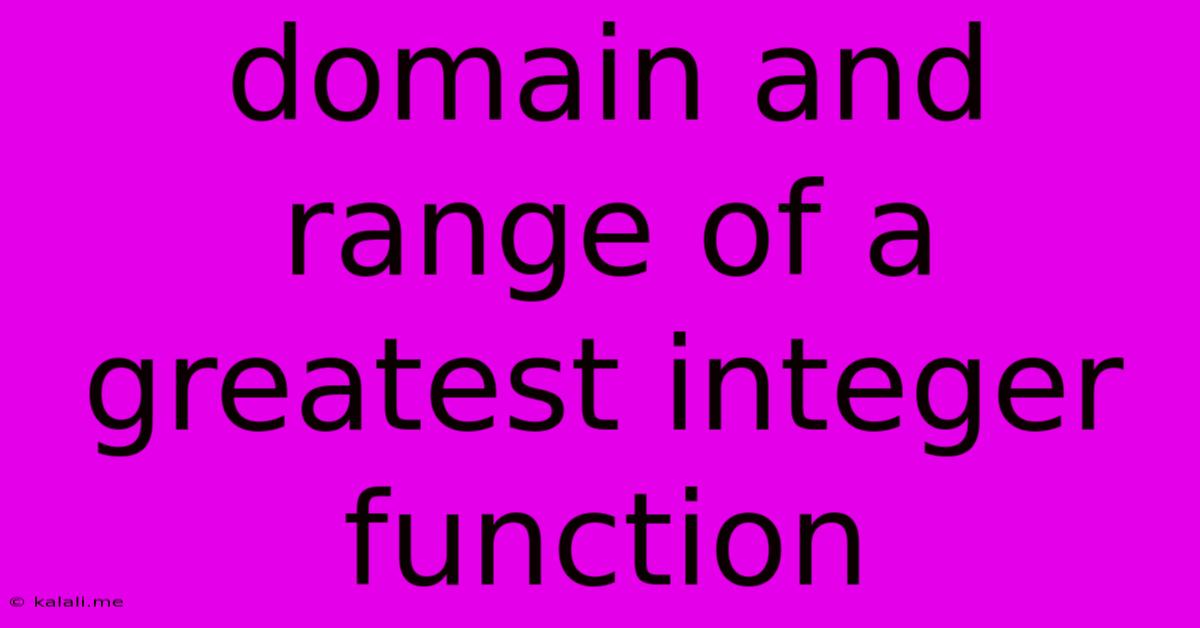Domain And Range Of A Greatest Integer Function
Kalali
Jun 12, 2025 · 3 min read

Table of Contents
Understanding the Domain and Range of the Greatest Integer Function
The greatest integer function, often denoted as ⌊x⌋ or [x], is a fascinating mathematical concept with straightforward yet sometimes tricky applications. This article will delve into understanding its domain and range, providing clear explanations and examples to solidify your grasp of this important function. Learning about the domain and range is crucial for graphing and solving problems involving greatest integer functions.
What is the Greatest Integer Function?
The greatest integer function, also known as the floor function, outputs the greatest integer less than or equal to the input value. In simpler terms, it rounds a number down to the nearest integer. For example:
- ⌊3⌋ = 3
- ⌊3.7⌋ = 3
- ⌊-2.3⌋ = -3
- ⌊0⌋ = 0
Determining the Domain of the Greatest Integer Function
The domain of a function represents all possible input values (x-values) for which the function is defined. The greatest integer function is defined for all real numbers. You can input any real number, whether positive, negative, or zero, and the function will output a corresponding integer. Therefore, the domain of the greatest integer function is:
Domain: (-∞, ∞) or All Real Numbers
Exploring the Range of the Greatest Integer Function
The range of a function represents all possible output values (y-values) that the function can produce. Since the greatest integer function always outputs an integer, its range is limited to the set of all integers.
Range: {..., -3, -2, -1, 0, 1, 2, 3, ...} or All Integers
Visualizing the Domain and Range
Graphing the greatest integer function helps to visualize its domain and range. The graph consists of a series of horizontal line segments, each spanning one unit along the x-axis. The function is discontinuous at each integer value, creating a "step-like" appearance. Observing the graph reinforces that the function accepts any real number as input (domain) and produces only integer outputs (range).
Practical Applications and Further Considerations
Understanding the domain and range of the greatest integer function is essential in various applications:
- Computer Science: Used in algorithms involving rounding down or integer division.
- Discrete Mathematics: Important in dealing with discrete quantities and sets.
- Signal Processing: Used in quantization and sampling of signals.
While the basic greatest integer function is relatively simple, variations and combinations with other functions can lead to more complex scenarios regarding domain and range. These require careful analysis of the function's composition. For instance, considering a function like f(x) = ⌊x²⌋ requires analyzing how the squaring operation impacts the input before the floor function is applied. Similarly, functions like g(x) = ⌊x⌋ + 1 will shift the range, whilst maintaining the same domain.
In conclusion, mastering the domain and range of the greatest integer function forms a strong foundation for working with this function in a variety of mathematical and computational contexts. Remember that the domain encompasses all real numbers, while the range is restricted to the set of all integers. This clear understanding provides a crucial stepping stone to tackling more complex problems involving this versatile mathematical tool.
Latest Posts
Latest Posts
-
What Is The Largest Ecosystem On Earth
Jun 13, 2025
-
Fire Safety Test Questions And Answers Pdf
Jun 13, 2025
-
Which Of The Following Has The Greatest Momentum
Jun 13, 2025
-
Are Metals On The Right Side Of The Periodic Table
Jun 13, 2025
-
What Is A Literal In Boolean Algebra
Jun 13, 2025
Related Post
Thank you for visiting our website which covers about Domain And Range Of A Greatest Integer Function . We hope the information provided has been useful to you. Feel free to contact us if you have any questions or need further assistance. See you next time and don't miss to bookmark.